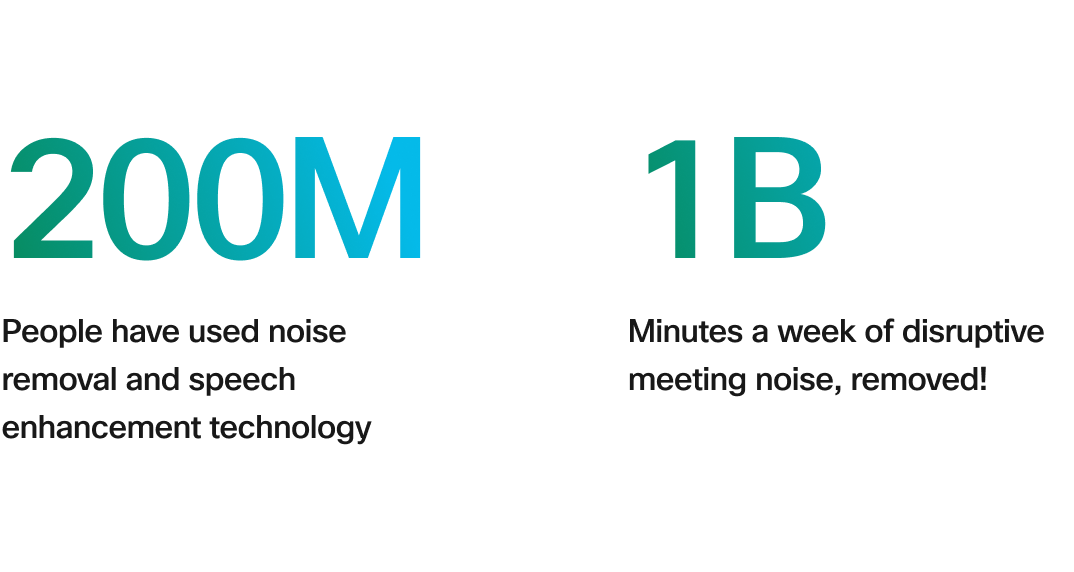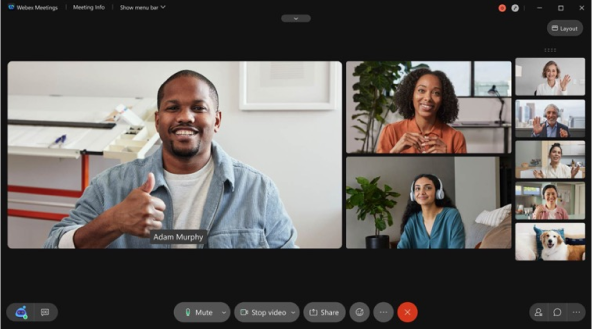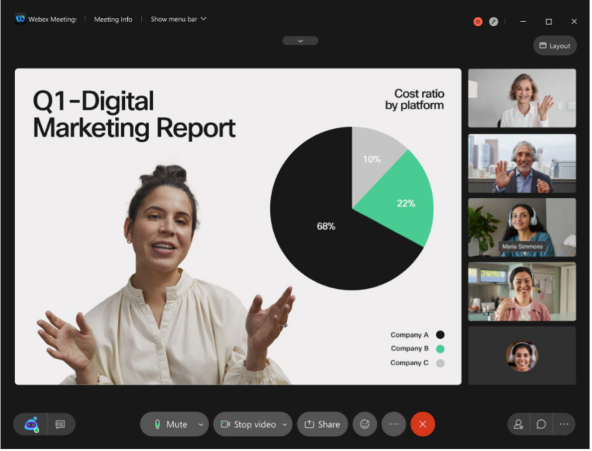Virtual meetings in 2023: Everything you need to know.

What is a virtual meeting?
Definition: A virtual meeting is a form of communication that enables people in different physical locations to use their mobile or internet connected devices to meet in the same virtual room. People use virtual meetings in many ways, including for connecting with family and friends, teletherapy, and collaborating with their distributed workforce.
In the business world, virtual meetings are usually held when employees are in different locations, but sometimes workers in the same office will opt for one simply so they don’t have to leave their desks. While virtual meetings have increased in popularity for work, they’ve also become commonplace for friends and family. Virtual meetings can be held with anyone, anywhere.
A virtual meeting is clearly different from a traditional in-person conference where everyone is together in the same physical room, but it's similar in that people are still brought together into a dedicated meeting room.
Note: some use “virtual meetings” and “online meetings” interchangeably, although one could argue there is a slight difference. A virtual meeting can be viewed as the broader term encompassing all types of digital meeting options ranging from video conferencing to meetings where attendees may join through cellular data rather than Wi-Fi.
With work environments shifting toward hybrid work models and more employees working remotely, the prevalence of virtual meetings will continue to grow. Consider these statistics from the 2021 Gartner® Magic Quadrant™ for Meeting Solutions (get the full report here):
- Through 2022, 75% of midsize enterprises will utilize a hybrid model with employees working both from a defined corporate office and from remote locations.
- By 2025, 50% of all enterprise virtual events will be held on the video meeting platform commonly used by their organization every day.
As technology and video meeting platforms become more advanced, meeting administrators can often provide virtual experiences that are more engaging, inclusive, and productive than in-person gatherings.
Why do we need virtual meetings?
Relationships are important for team members to form and maintain. As the adoption of hybrid work models rapidly increases, there are more employees in remote locations than ever before. Many of these employees have never visited the corporate home office of their employer, nor have they met their teammates in person.
In many situations, on-site visits and other forms of traveling have been rendered unnecessary as interviews, onboarding, orientation, and training can all be handled with virtual meetings. While these digital capabilities can save time and money, valuable elements of in-person interactions can be lost.
Team collaboration tools have come a long way, and the best vendors are working daily to digitally reclaim some of the aspects that may be lost through a lack of in-person connection.
The COVID pandemic taught the world many lessons, one of them being that meeting virtually can go a long way towards bridging the gap of physical distance. Many colleagues who had previously only worked together in-person were still able to deepen their connection, and in many cases even improve their productivity. Enabling video during virtual meetings can lead to more effective team collaboration, as coworkers can socialize, cooperate, and brainstorm ideas without losing the important elements of body language and facial reactions that can be invaluable when gauging the feelings and opinions of others.
What tools do I need for a virtual meeting?
Typically, to schedule a virtual meeting and invite others, a user would need a PC, laptop, or mobile device with a microphone or camera, online meeting software, and an internet/data connection. This person can then invite others who can join with as little as a landline phone. Virtual meetings are flexible and capable of accommodating attendees who can only join with their voice via a phone connection (and, of course, others who have video capabilities enabled on their mobile phones or computers).
Meeting software can be run via mobile or desktop apps and within internet browsers. There are many vendors to choose from and, like all forms of software, quality and features will vary.
What are the types of virtual meetings?

As touched on earlier, there are different types of virtual meetings that meeting platforms can support. The host decides on the meeting style for achieving whatever their goals may be for a specific meeting. They may decide that the main presenter needs to have the entire focus of the attendees, or maybe that video is unnecessary. A virtual meeting solution should have a wide range of options to customize how a meeting is hosted and attended. There are a handful of broad meeting types that can be tweaked for specific needs and wants.
1. Video Conferencing
Video conferences are a very popular meeting type as they involve the most face-to-face interaction. These virtual meetings feature high-quality video and audio for participants to see and hear each other as though they are in the same room.
This type of meeting is the best for seeing body language, facial expressions, and other physical cues. As a result, video conferencing is the best form of virtual meeting if you want to facilitate team and relationship building.
2. Web Conferencing
Web conferences can be very similar to video conferences and can involve face-to-face meetings, but the main goal is to collaborate on projects by using capabilities like sharing and whiteboarding.
Brainstorming sessions are a very popular type of web conference and can be more efficient than in-person gatherings. With cloud-based collaboration solutions ranging from simple Word documents to feature-rich digital whiteboards, teammates can meet while also working inside of the same shared resource – all in real-time and from the comfort of their own desks.
3. Webinars
While webinars are a variation of web conferences, they are primarily a one-way seminar with hosts or panelists presenting to attendees. Settings for webinars can be set so attendees cannot be seen or heard, giving hosts the uninterrupted focus of attendees. The hosts or admins have great control over webinars and can decide, at any time, to open up audio or video permissions for others. This is typically done if there are Q&A sessions at the end of presentations.
Webinars have become increasingly popular for organizations to drive demand for their products through thought leadership sessions or technical demos hosted by subject matter experts. These sessions can be highly interactive and very valuable for attendees that would like to get direct answers to questions about products they are interested in.
Modern virtual meeting platforms should include within them a complete virtual events platform with features to improve the attendee experience such as polling, gesture recognition, real-time translation of over 100 languages, and the ability to accommodate thousands of attendees.
4. Teleconferencing
The simplest and most barebones type of virtual meeting is a teleconference. These are audio-only meetings and are the more modern versions of a “conference call.” Because no video is involved, teleconferences require less technology and can be better suited for quick and informal calls that do not need screen sharing or other visualizations.
Teleconferences still take advantage of features within virtual meeting platforms by offering ease of use and simple, secure connectivity for users.
What are the advantages of virtual meetings?
The most obvious advantage of a virtual meeting is that people can host and attend them from anywhere. Workers can get together from the comfort of their homes without worrying about gathering in the same physical place. Having this ability can help resolve problems that can arise from scheduling conflicts, travel issues, office closures, and other possible business disruptions.
Virtual meetings can also empower better collaboration among teammates. With screen sharing, chat, polling, and other components, attendees can experience meetings that are more interactive than ever before. Advanced AI-powered features like closed captioning and live transcription can also help everyone capture all the details of what is being said. Here are two statistics about how our customers are using these types of features:

One of the most popular and useful virtual meeting capabilities is recording. With recordings, attendees can go back and watch or listen to a previously attended meeting as many times as they want. Gone are the days of trying to frantically keep up with meeting presenters, or later attempting to recall what was said in the meeting.
On top of the outlined benefits of conferencing, businesses can save a significant amount in costs. With a hybrid work model and virtual meeting capabilities, an organization will have less overhead in areas like travel and office space leases.
What are the disadvantages of virtual meetings?
While virtual meetings can definitely have a positive impact on productivity, there can also be some drawbacks as anyone who has been in their fair share of virtual meetings can attest.
The first and possibly most frequent problem with virtual meetings is when users have technical trouble logging into meetings and contributing. While the platforms can be very user-friendly and intuitive, there can be learning curve issues for new participants, along with actual technical roadblocks, like server or internet connection outages.
The mute button can also be a source of irritation for attendees. A person may forget to unmute themselves when it’s their turn to speak. Or, they may forget to mute themselves while there’s distracting background noise coming from their end.
These are all very familiar annoyances for video conferencing veterans. These challenges can cause frustration, which can lead to losing focus during meetings, which can ultimately lead to less productivity.
Another common complaint is that virtual meetings are less personable. Many people prefer face-to-face, in-person interaction. Relationships and even friendships among team members can often be fostered better when everyone is together in the same space.
These are all valid weaknesses, but collaboration tools are continuously evolving with AI-enabled technologies like noise cancellation to improve virtual meeting experiences.
What features should a virtual meeting platform have?

The marketplace for virtual meeting platforms has gotten very competitive over the last few years. As enterprises, small businesses, and even individual users are all seeing the benefits, vendors have attempted to address many of their specific needs and wants. This wide range of diverse users has pushed engineering teams to roll out some very impressive feature sets.
Like all forms of software, virtual meeting solutions are not created equal. Buyers should research and attend various demos before committing to a platform. It’s important for buyers to keep in mind that they are not only choosing a vendor’s platform, they are choosing a partner who they believe will provide for their needs now and into the future. That said, the best virtual meeting platforms should include the following features:
- Reliable HD audio and video – Meetings should stay connected without technical hiccups and the audio and video should sustain consistent high-definition quality so participants can see and hear everything clearly.
- Intuitive controls and single-button sign on – Joining a meeting should be simple enough for anyone to figure out. New and non-technical users of virtual meeting platforms must be able to figure things out from a straightforward interface. A quick joining capability helps to make sure everyone gets into the meeting on time and without technical delays.
- Screen sharing – Having the ability to share your desktop is an absolute must when collaborating or presenting remotely. Screen sharing capabilities should also allow real-time editing and whiteboarding that everyone can engage with.
- Direct and group messaging – Being able to message with others one-on-one or in a group during meetings enables the meeting to go on uninterrupted as information is shared in side conversations. Messaging should be available 24/7 and not just during meetings.
- Powerful administrator controls – Meeting hosts should have a wide range of features and customizations that can be tweaked to meet the specific needs and goals set for every individual meeting.
- Recordings and transcriptions – With complete meeting recordings and automatic transcriptions, the productivity of every conference can be maximized. Traditional note-taking may still be helpful, but team members must be able to go back and review meeting materials as many times as they like to make sure they didn’t miss a thing. And if someone wasn’t able to attend, they can easily get back up to speed.
- Calendar Integrations – A sync with meetings calendars will provide a full view of upcoming meetings without having to bounce back and forth between applications.
- A mobile app – Giving users a mobile app will allow the hosting and joining of virtual meetings from wherever people go, with nothing more than a smartphone.
In addition to these basic features, even more advanced AI-powered capabilities are offered by premium virtual meeting platforms. Some of these are:
- Real-time translations – Communication with all global teammates is possible with real-time translations, regardless of what languages everyone speaks. This feature will instantly provide translated subtitles of the live speaker’s speech.
- Background noise removal – This technology can automatically remove distracting and unwanted sounds while enhancing speech for even clearer audio.
- Gesture recognition – With these recognition abilities, attendees can send live reactions during meetings using nothing more than their hands.
- Custom layouts – Users can organize their view of speakers, other attendees, and presentations into an arrangement that they prefer.
- Smart backgrounds – Distractive and unattractive backdrops behind meeting attendees can be replaced with more pleasing and appropriate scenery.
- Meeting assistant – Meeting attendees and hosts can use voice commands to get live help to adjust settings or enable features.
With these innovative features, meetings can be more efficient and productive than ever.
What are some tips for running successful virtual meetings?

- Prepare an agenda – Having a meeting agenda will help you cover all necessary topics and will keep the meeting from running off into unproductive tangents. Share this information with attendees ahead of time so they can come ready to ask or answer questions.
- Locate yourself appropriately – As a meeting host, you should be in a quiet spot with a good internet connection. Also, depending on the type of meeting, consider how your background may engage or distract others.
- Start on time – Conduct your meeting as you would if you were hosting an in-person conference. Respect everyone’s time and begin promptly to avoid an overrun at the end of the meeting.
- Familiarize participants – If your attendees have not met, quickly introduce them to each other to provide a more comfortable and psychologically safe environment where open discussion is encouraged.
- Engage everyone – Even if your meeting attendees prefer not to speak much, they can still use the other tools of your virtual meeting platform to contribute to the conference. Promote the use of capabilities like messaging and digital whiteboarding to get involvement from everybody.
- Manage disruptions – If you are noticing loud background noises or other distractions, address them right away and ask participants to either mute themselves or take care of the problem.
- Stay on track – When the discussions veer off into unproductive topics, keep the team focused on the agenda and politely let everyone know that you will be keeping a list of the other issues to cover at the end of the meeting, or at a later time.
- Provide a wrap-up – Make sure to reserve time at the end for a proper summary of your meeting. Go over what action items were decided on, who the deliverable owners are, and when they will be due. And be sure to let everyone know when the next meeting will be (if there is one).
- Finish on time – Close your meeting at the originally specified ending time and let attendees get back to their other responsibilities. Show that you respect people’s time and run organized meetings. Doing so will likely give others a positive attitude about conferences that you host. Follow up offline with individuals if there were concerns that weren’t resolved.
How can I prepare for a virtual meeting?
If you aren’t the host of a virtual meeting and are joining as an attendee, there are still some important steps you should take to properly prepare, especially if you are being virtually interviewed.
- Review the agenda – Ensure that you are coming to the meeting with your assigned pre-meeting actions completed, or with the information that was requested of you.
- Inform others – Let any other people that may be around you know that you’re going to be in a virtual meeting and that you would appreciate no distractions.
- Check your internet connection – Make sure that you have a fast and reliable internet connection to make sure others will see and hear you without disruption.
- Situate yourself ideally – Attend the meeting from a location with limited background noise and where there is nothing distracting behind you. Implement a virtual background if you need to.
- Check your settings – Give your meeting settings a review and turn off any non-professional features that you may have switched on. This includes any voice modification, fun or inappropriate virtual backgrounds, and video filters.
- Frame yourself well – Before your meeting, do a quick preview of your video feed and adjust your positioning so you’re centered well in your video frame.
What are some icebreakers for virtual meetings?
With the rise of hybrid work models and the dependence on virtual meetings, attendees frequently meet each other for the first time over video.
Virtual meeting icebreakers are a quick and easy way for people to discuss topics that aren’t work related and get to know one another. And for teammates that already know each other, icebreakers can help lighten the mood and start meetings off with a light tone.
Using capabilities like live polling and whiteboarding can gamify icebreakers and boost interactivity, making them even more fun. Here are some ideas for your next virtual meeting:
- Ask where everyone is joining from. This question is great for larger gatherings and the results can be interesting when the results show a widespread and global representation.
- Have each attendee do a quick introduction of someone else that’s with them where they are working. This could be a child, significant other, or even a pet.
- Start off with asking team members to send an emoji or even use a whiteboard to illustrate their current mood.
- Play a quick round of trivia. Make sure to ask your teammates what their favorite trivia topics are to get them more motivated to participate.
- Set up a poll with some light-hearted questions and display the results to get some conversations going.
- Begin with an informal coffee or tea break, or even schedule it for later in the meeting. A light-hearted conversation over beverages can always put people at ease.
- Send all your potential meeting attendees your favorite personality test beforehand and get everyone to share their results during the conference. These can provide insights into the personalities and personal lives of attendees that others weren’t aware of.
- Use digital whiteboarding features for an exciting game of Pictionary. Opening with a quick game of Pictionary can create a memorable virtual meeting.
What kinds of virtual meeting backgrounds are available?
One of the most used features is the virtual background. In the not-so-distant past, virtual backgrounds didn’t look that great. They frequently obstructed attendees and had a choppy, inconsistent appearance.
But, in recent years, and with the help of AI-powered movement recognition, the quality of virtual backgrounds has been significantly enhanced.
Virtual backgrounds allow meeting attendees to replace their actual backdrop with something more business appropriate, or even something fun and informal.
Virtual meeting platforms now provide a wide range of options for different kinds of audiences, but attendees and hosts should always consider their audience before implementing a specific virtual background. Some examples of virtual background options are:
- A blurred version of your existing real backdrop
- A solid color
- Pre-loaded office environments
- Pre-loaded home and outdoor environments
- Any image you upload
How can my company work smarter with Webex?
With Webex by Cisco, your organization can experience all the benefits and features of a leading enterprise-grade collaboration platform. With our comprehensive virtual meeting solution, your teams will be fully enabled to work together from anywhere.
Hosts and attendees will be able to engage with each other like never before, creating an even more productive and collaborative work environment. You can also give prospects and customers a new channel to learn about products and services, and allow them to interact directly with your experts.
With constant innovation and updates, Webex provides significant ongoing enhancements and differentiating advantages over other collaboration suites. Thanks to these, Cisco was recognized by Gartner in October 2021 for the fifteenth time as a market leader for Meetings Solutions (download the full report). In it, the authors state:
“Given Cisco’s high scores across all five use cases, its Webex offering should be considered by midsize to the largest multinational corporations for the use cases covered in this report.”


